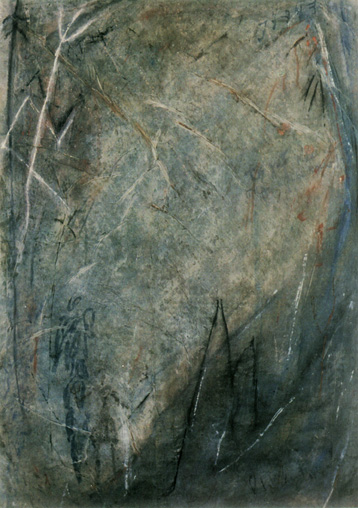 MACANESE, 1990, 50×50 cm
MACANESE, 1990, 50×50 cm
Puglia arrived from the hot Italian earth in search of new spaces for the shapes and colours which burst from his canvasses. Macau, where he lingered long enough to produce some work, held a strange, intense and enveloping fascination for him. This mélange of rhythms and rites, where Western shading merges into tones of the Orient, has an immediate effect on every artist, Salvatore Puglia is still a young man and his paintings reflect a singular authenticity which is often more difficult to find in established painters. Emotion and intellect mingle in the same cocoon, melting together in a single expressive motion which has the breadth of the modern world. And yet this painter, whose size is in inverse proportion to his talents, did not arrive in Macau a novice. He has held frequent exhibitions -- five in a row in only three years -- in Paris, Strasbourg and Naples, all cities which demand only the best. Jacques Derrida, in his essay entitled "Sauver les Phénomènes", also gives his seal of approval to Puglia: Salvatore Puglia, without a doubt an Italian painter, Roman by name and surname, but who brings into play or, if you like, brings to life foreign languages: Greek, German, French, sometimes English. How does one paint in several languages? What does painting have to do with translation? And what do proper nouns become on the canvas? These are some of the questions on which Derrida ponders. In another section, the French essayist admits that, by signing his paintings with the monogram S. P., Salvatore is devoting himself to the inscription: incision, vibration, typesetting. printing, seal, stamp, graft, inclusion as occurs in the watercolour Infus Ubique (1986) in which the name does not seem to conflict so much as link in (in parenthesis) with the name of the object in spatial terms, in the place which seems to precede the inscription, the place which seems to make room for and open itself up to a European model (the triangle formed by Greek, Latin and German).Carlos Marreiros, another close observor of Puglia's work, widens Derrida's linguistic triangle to include both Portuguese and Chinese influences, influences which are combined in the expression 'Macanese', which has an irresistable "topological and topographical appeal". This word, with all its depth and extensive connotations, is brought into focus on the canvasses shown in Salvatore Puglia's Macau exhibition which was open to the public from the 22nd of February to the 5th of March in the art gallery of the Portuguese Bookshop, an area set aside for cultural initiatives of various kinds.
The catalogue to this exhibition is worth a mention. The eyes rest on images which are opaque and yet transparent, intimate yet wild, where lines and tones come together in sensual garlands which can be interpreted however the observor desires. Carlos Marreiros explains in his introduction to the exhibition: The pictograms in his dynastic yet virginal calligraphy combine with lined gestures and incisions, seals or the thousand million scufflings of the myopic, gaudy millipede, dashing off "s's" on the surface of earthy ochre, rusty ochre, greyish ochre, greyish green, greenish blue, bluish green, greenish something-or-other, the slippery verdigris of graffitti scribbled on walls, or of Macau.
Salvatore Puglia's exhibition, "Small Talks", presented fifteen different works created in total unawareness of any dominant trend. Personal and intransmissable, they demand a reaction from the observor... for they enrapture the observor. Exhibitions like this one are an obvious reflection of artistic maturity. Macau deserves to host them at a point in time when culture, as well as other aspects of our society, is sufficiently unreined to search out new directions.
Chinesices de Salvatore Puglia

H. F. A., 1989, 103×148cm
start p. 119
end p.